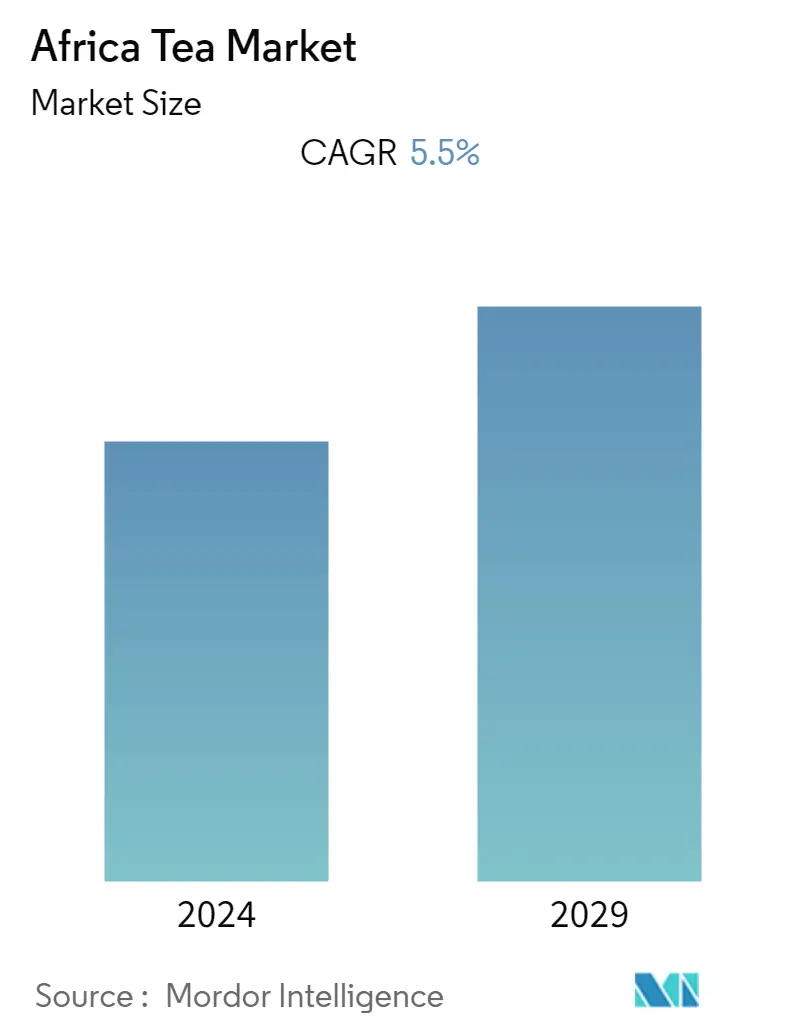Market Size of Africa Tea Industry

| Study Period | 2019 - 2029 |
| Base Year For Estimation | 2023 |
| Forecast Data Period | 2024 - 2029 |
| Historical Data Period | 2019 - 2022 |
| CAGR | 5.50 % |
| Market Concentration | Low |
Major Players
*Disclaimer: Major Players sorted in no particular order |
Africa Tea Market Analysis
The African tea market is projected to reach a CAGR of 5.5% during the forecast period, 2022-2027.
The tea industry in Africa is a labor-intensive industry. In Africa, Malawi alone employs a workforce of around 50,000 unskilled and semi-skilled workers. The peak seasons for tea plucking and production in Africa are from March to September, presenting a high risk of COVID-19 transmission due to the high concentration of people on the estates and in the factories. As the biggest tea exporting country in Africa, the tea sector industry in Kenya has experienced transportation disruptions from the tea-producing areas to the port of Mombasa and some consequential disruptions in cash flow. The impact on tea production itself so far seems limited. However, there was a clear increase in tea consumption during the pandemic as in-house consumption increased.
Over the medium term, increased health awareness, health benefits caused by tea, and a surge in disposable income are expected to drive the growth of the African tea market. Moreover, many market players focused on introducing additional healthy ingredients in tea, contributing to the overall market growth. Factors like introducing new flavors and varieties and rising demand for herbal tea are expected to bring more growth opportunities to the tea market.
Health and wellness are the major factors boosting the demand for smaller specialty teas in Africa, including fruit/herbal tea and green tea, which recorded strong retail volume growth in 2021, despite their higher than average unit prices.
Africa Tea Industry Segmentation
Tea is an aromatic beverage made by pouring hot or boiling water into cured or fresh leaves of Camellia sinensis (Tea plant). The African tea market is segmented by form, product type, distribution channel, and geography. On the basis of form, the market is segmented into leaf tea and CTC tea (crush, tear, and curl tea). On the basis of product type, the market is segmented into black tea, green tea, and other types (white and oolong). On the basis of distribution channels, the market is segmented into supermarkets/hypermarkets, specialist retailers, convenience stores, online retailers, and other channels. Additionally, on the basis of geography, the report covers South Africa, Egypt, and Rest of Africa. The report offers market size and forecasts in value (USD million) for the above segments.
| By Form | |
| Leaf Tea | |
| CTC Tea (Crushed, Teared, and Curled Tea) |
| By Product Type | |
| Black Tea | |
| Green Tea | |
| Other Types (White and Oolong) |
| By Distribution Channel | |
| Supermarkets/Hypermarkets | |
| Specialist Retailers | |
| Convenience Stores | |
| Online Retailers | |
| Other Channels |
| Geography | |
| South Africa | |
| Egypt | |
| Rest of Africa |
Africa Tea Market Size Summary
The African tea market is experiencing a dynamic phase of growth, driven by increasing health awareness and a rise in disposable incomes. The industry is characterized by its labor-intensive nature, with significant employment in countries like Malawi. Despite challenges such as transportation disruptions in Kenya, the market has shown resilience, with a notable increase in tea consumption during the pandemic. The market is witnessing a shift towards health-oriented products, with a growing demand for specialty teas, including herbal and fruit varieties, which offer functional benefits. The introduction of new flavors and the incorporation of healthy ingredients are further propelling market expansion, as consumers seek products that align with their wellness goals.
The market landscape is highly competitive, with multinational, regional, and local players vying for market share. Key players such as Tata Tea, Dilmah, and DavidsTea are actively engaging in product innovations and strategic partnerships to enhance their offerings. The ready-to-drink (RTD) segment is gaining traction, supported by the health and wellness trends prevalent in the region, particularly in South Africa. Green tea and rooibos variants are becoming increasingly popular due to their perceived health benefits. The market's fragmented nature and the ongoing introduction of new products and flavors underscore the vibrant and competitive environment of the African tea industry.
Africa Tea Market Size - Table of Contents
-
1. MARKET DYNAMICS
-
1.1 Market Drivers
-
1.2 Market Restraints
-
1.3 Porter's Five Forces Analysis
-
1.3.1 Bargaining Power of Suppliers
-
1.3.2 Bargaining Power of Buyers/Consumers
-
1.3.3 Threat of New Entrants
-
1.3.4 Threat of Substitute Products
-
1.3.5 Intensity of Competitive Rivalry
-
-
-
2. MARKET SEGMENTATION
-
2.1 By Form
-
2.1.1 Leaf Tea
-
2.1.2 CTC Tea (Crushed, Teared, and Curled Tea)
-
-
2.2 By Product Type
-
2.2.1 Black Tea
-
2.2.2 Green Tea
-
2.2.3 Other Types (White and Oolong)
-
-
2.3 By Distribution Channel
-
2.3.1 Supermarkets/Hypermarkets
-
2.3.2 Specialist Retailers
-
2.3.3 Convenience Stores
-
2.3.4 Online Retailers
-
2.3.5 Other Channels
-
-
2.4 Geography
-
2.4.1 South Africa
-
2.4.2 Egypt
-
2.4.3 Rest of Africa
-
-
Africa Tea Market Size FAQs
What is the current Africa Tea Market size?
The Africa Tea Market is projected to register a CAGR of 5.5% during the forecast period (2024-2029)
Who are the key players in Africa Tea Market?
Tata Tea, Dilmah, Hain Celestial, DAVIDSsTEA and Vanrees are the major companies operating in the Africa Tea Market.

